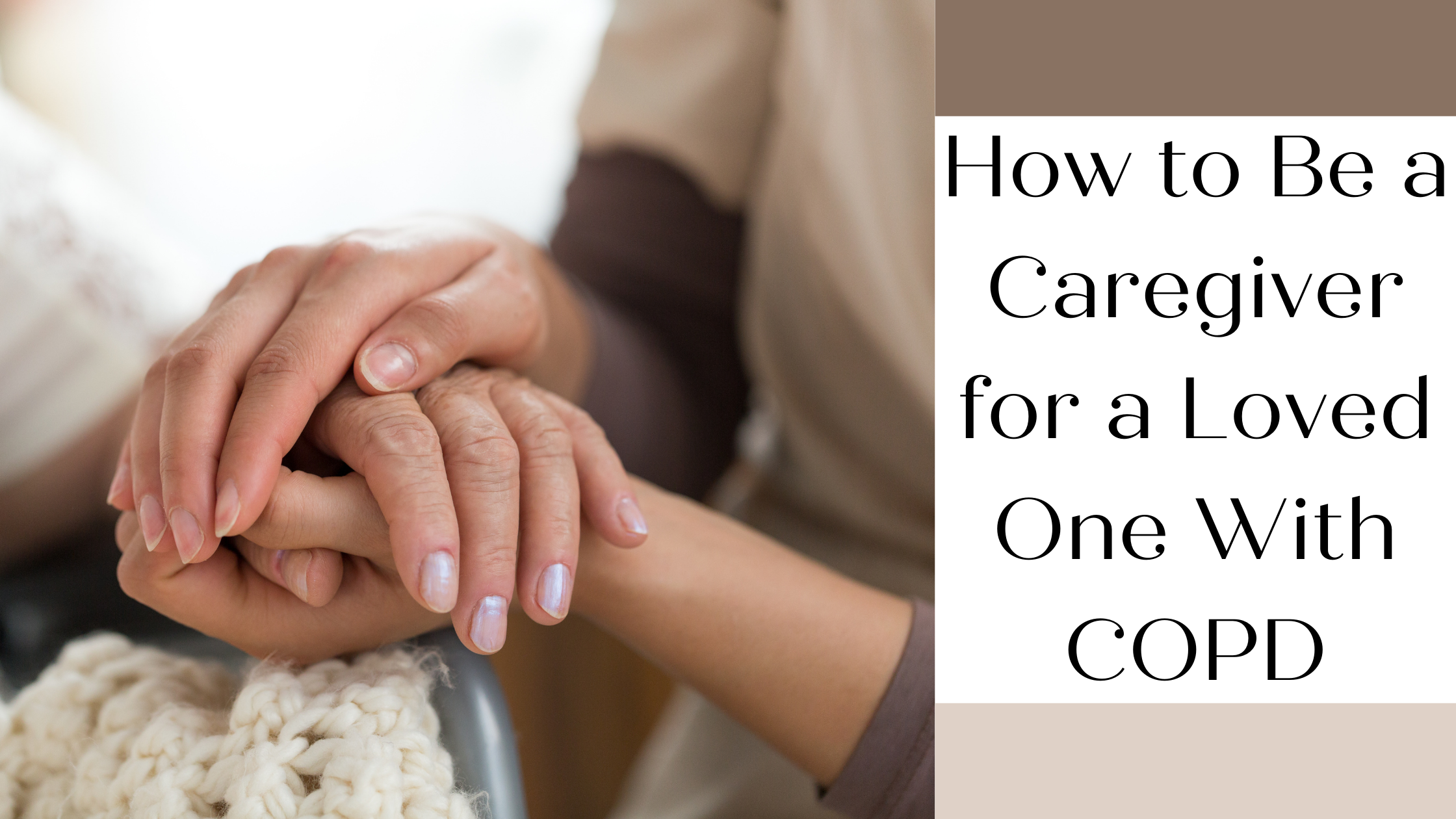
Caregivers are either naturally selfless people or they becomes selfless as their role of a caregiver develops. Caregivers take on a difficult job that often requires sacrifice in order to care for their loved one. This article is for you, the caregivers out there who need some advice about how they can continue to care for their loved one, but also take care of themselves.
It is so important for you to take care of yourself because only when you first help yourself can you effectively help others. Caring for yourself is one of the most important—and one of the most often forgotten—things you can do as a caregiver. When your needs are taken care of, the person you care for will benefit, too.
We hope that the caregiver and the patient can read this article together and find helpful ways to work through their difficulties managing and treating COPD together.
What is COPD
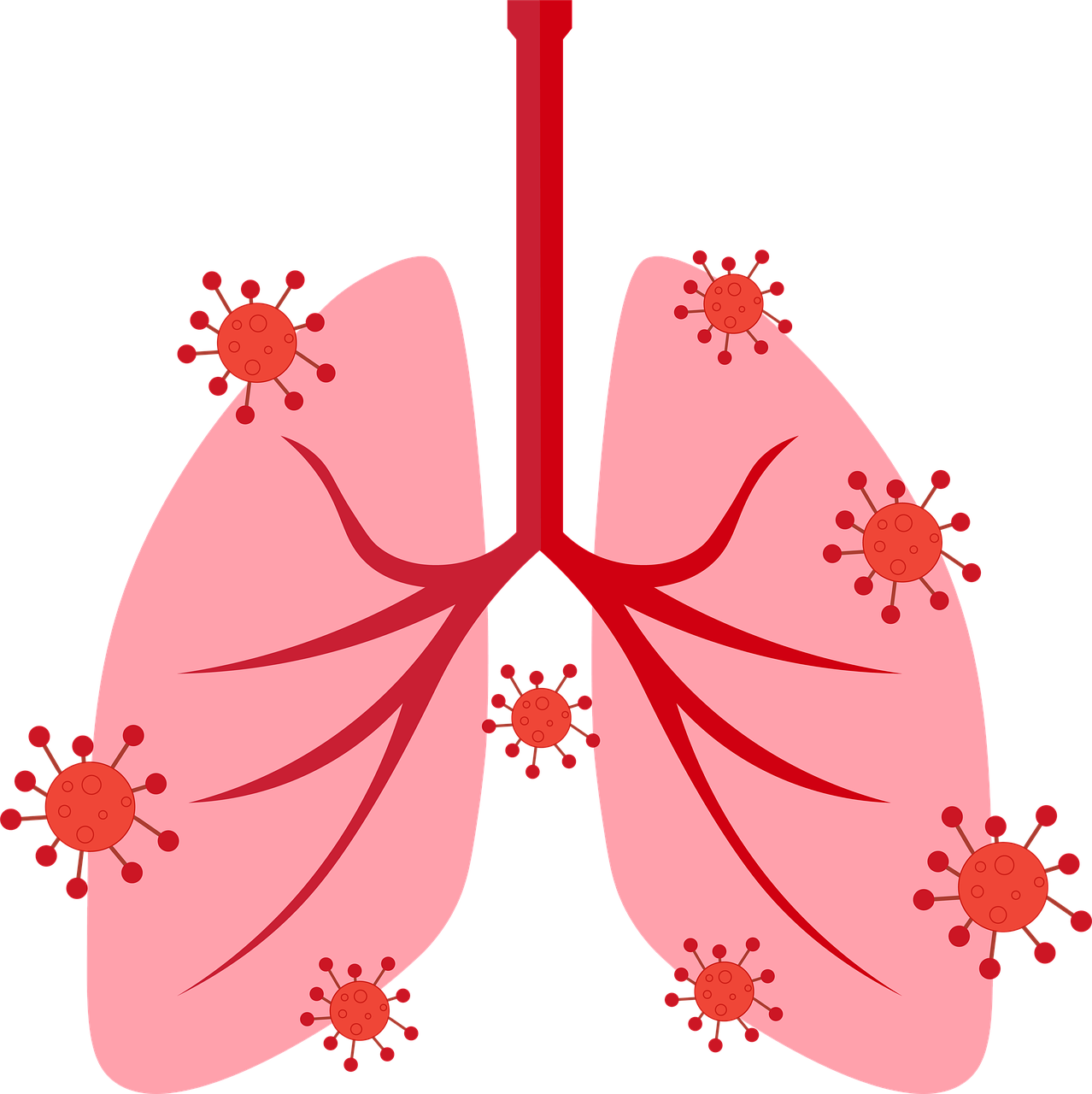
The first thing you must do is to understand what Chronic Obstructive Pulmonary Disease is, and there are three main forms of COPD:
- Chronic bronchitis, which involves a long-term cough with mucus
- Emphysema, which involves damage to the lungs over time
- Some patients have both conditions listed above
All of which make it hard for the COPD patient to breath because their airways become inflamed, damaged, and restricted by excess mucus. This causes a number of other issues throughout their body across all of their systems. With lack of oxygen comes low blood saturation levels, bone decay, added stress on the circulatory system, and a list of other complications.
COPD is treatable, and people can live with this disease for many years despite how severe it gets. There are ways to learn how to manage the disease and even slow down the progression of COPD. It requires a strict treatment plan that the COPD patient and their caregivers can develop with their doctor. Actually executing this treatment is the hard part, and where the caregivers role is essential.
So let's talk about our caregivers.
Being a caregiver
-jpg.jpeg)
There are over 40 million families worldwide in the caregiver role for a spouse, parent, friend, or other loved one, no matter the circumstance this is no easy task but it is an important one. It should not be taken lightly! Both the patients and the caregivers are in a hard position where intense lifestyle changes and everyday norms are flipped upside down.
If the patient has a condition like COPD, the caregiver's role likely evolved over time once their symptoms started progressing and through the diagnosing process, rather than a sudden change like an accident where a patient was healthy one day and hurt the next.
Because COPD is a progressive disease meaning it gets worse over time, both the caregiver and the patient will go through different stages of the disease together changing and altering everyday activities to adjust to a more comfortable lifestyle.
As a COPD caregiver, your main focus will inevitably be your loved one. However, your own health and well-being is important for you and the one you are caring for. This means remembering to take care of your own needs. As we mentioned above, this is not an easy job, and it is easy to feel overwhelmed.

Here are some tips for taking care of yourself as a caregiver:
Some of the most common impacts caregiver experiences are listed below:
- Sleep deprivation
- Poor eating habits
- Failure to exercise
- Failure to stay in bed when ill
- Postponement of or failure to make medical appointments for themselves
{{cta('b59df0c1-c4de-47a8-8e1c-0d33d4b414aa','justifycenter')}}
If you experience any of these lifestyle changes as a caregiver it is important to find tips for managing and adjusting your habits in order to live a more productive and happier life.
Here are some tips you can focus on. These tips were developed to help you get into a sleep scheduled, eat healthier foods, exercise more regularly, taking care of yourself when sick, and to remind you that you should make medical appointments for yourself when necessary.
Tip #1 Reducing stress
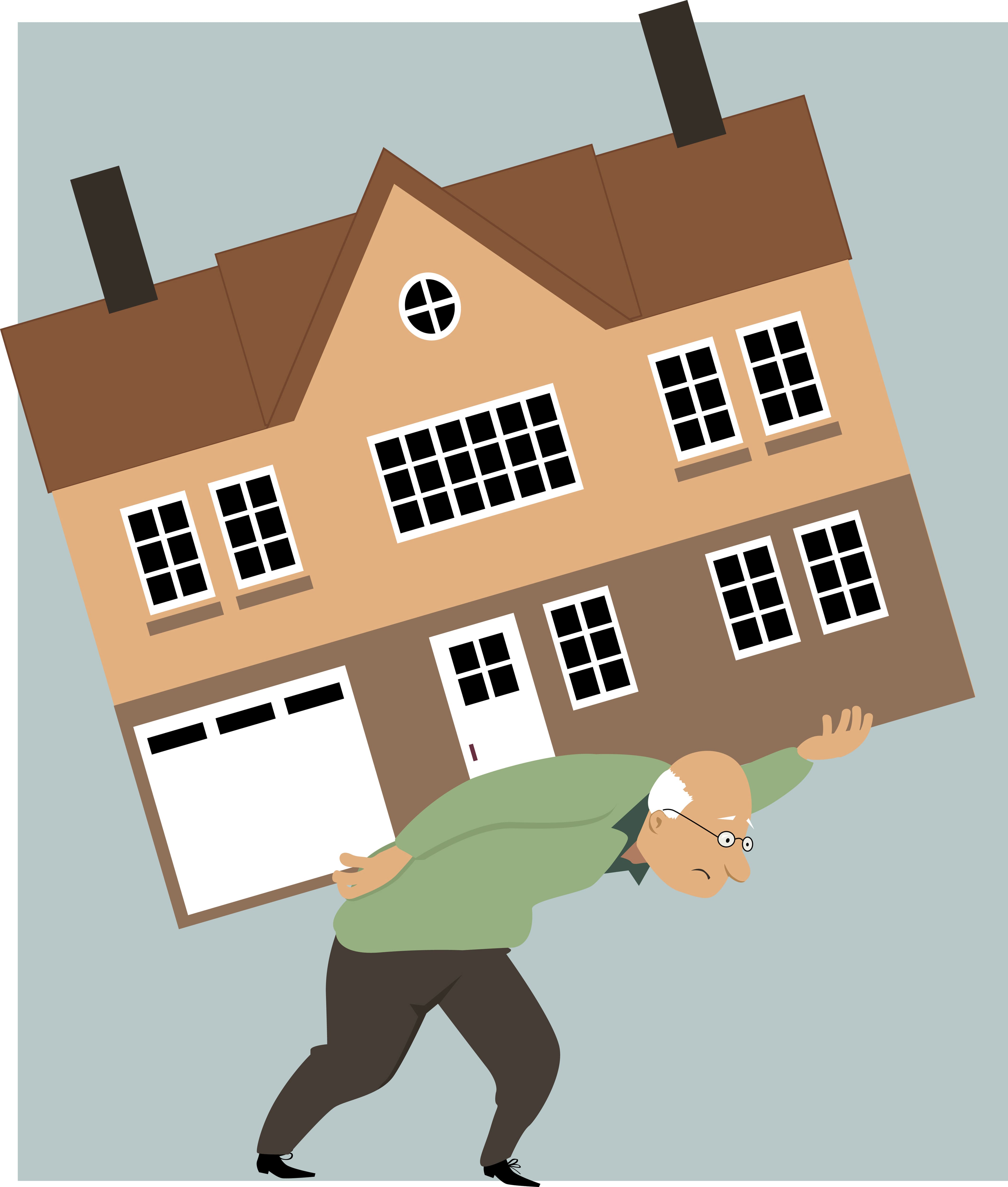
Caregivers are under a lot of stress all day long everyday, one of the best easy to avoid feeling stressed is to adjust to a strict sleeping schedule. Studies show the effects of sleep deprivation are related to a person's exposure to severe environmental and operational stress and negatively impacts their cognitive performance. This particular study sourced from Springer Link explains the results of a study that sleep deprivation and environmental stress adversely affects a person’s performance and mood.
You can also work to recognize stress warning signs early. This means realizing your irritability, sleep problems, and forgetfulness early on so it doesn't get worse. You can learn how to recognize your own warning signs, and be capable of making effective changes. Donʼt wait until you are overwhelmed.
You can also begin to identify the sources of your stress. Ask yourself, “What is causing stress for me?”
Sources of stress might include:
- you have too much to do
- family disagreements
- feelings of inadequacy
- the inability to say no

After you can put a source to your stressful feelings identify what you can and cannot change.
Remember, we can only change ourselves and our own behavior, and someone else’s actions are out of our control. When your focus is wrongly adjusted on things you cannot change or control, you will only increase your sense of frustration.
Ask yourself, “What do I have some control over? What can I change?” and even if you can only make a small change, this can make a big difference.
The last thing is to take action. These types of active decisions to reduce stress gives you back a sense of control that you deeply need. Stress reducers can be simple activities:
- Walking
- Other forms of exercise
- Gardening
- Meditation
- Having coffee with a friend
- Identify some other stress reducers that work for you
{{cta('fa8abc2a-1e88-4fa3-82fd-1cb5b9ed43b2','justifycenter')}}
Tip #2: Set goals for yourself
You can set a variety of goals all having different timelines, and it's a great way to stay in check with what matters to you.
Some goals you might try to set are:
- Taking a break from caregiving
- Get help with caregiving tasks like bathing and preparing meals
- Engage in activities that will make you feel more healthy
You do not want to get overwhelmed with accomplishing too many goals at once. Instead focus on one of two so that you can work towards those ideas productively.
The next step is to make an action plan, you can do this by asking yourself, “What steps do I need to accomplish to reach my goal?’” Then you can determine which step you will take first, and when.
Here is an example of how to set and make a plan for accomplishing goals:
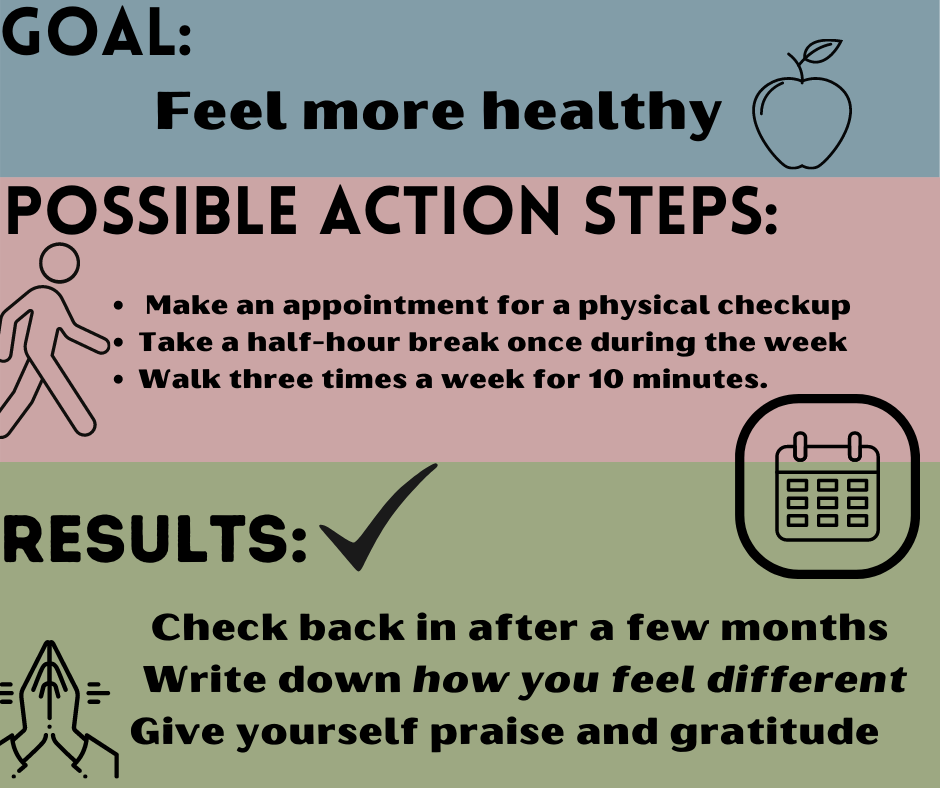
Tip #3 Finding a solution
Your priority as a caregiver has been to seek solutions for your patients to difficult situations. You also have to do this for yourself!
If there is an issue in your life, for insistence, you are not going to the doctor for your own check ups or you get out of bed while you are sick, you must start taking action to solve this.
Making active choices to change the situation at hand will encourage a positive attitude, also giving you more confidence in your abilities.
Tip #4 Find accurate information

COPD is not always genetic, and it most often caused by smoking or inhaling harmful irritates, therefore, you may have never known anyone with COPD in your life, so understanding this new disease as a caregiver, can come as quite a shock.
A quick google search isn’t always the best way to research aspects about COPD especially because COPD is not a one size fits all diagnosis. This means that whoever you are taking care of with COPD is very different than anyone else with the same diagnosis.
The first thing is creating a strict treatment plan with your doctor, as well as establishing a relationship with your doctor, physical therapist, pulmonary therapist, or other related health care professional. Your doctor will create a specific treatment plan for their COPD and how COPD affects your life. By establishing a relationship you will be able to call and ask questions, seek help, and advice, rather than guessing.
One of the most important parts about a patients COPD treatment regime is long term oxygen therapy. Oxygen therapy is used for COPD who’s oxygen saturation is 92% or below while breathing air. This means the patient has a low enough blood oxygen level, also known as dyspnea, to qualify for a long term oxygen prescription.
The most effective, modern, and cost effective option for long term oxygen therapy, is utilizing a portable oxygen concentrator. These devices are built to last a long time, and they are designed to be portable, and can even be taken on airplanes.
As a caregiver, it is important for you to be able to take time off, and rest.
If your loved one with COPD has their own portable oxygen concentrator, they will be able to take it with them alone to the store, or feel comfortable walking by themselves, because some units like the Caire Freestyle Comfort only weigh 5 pounds! This way if you need to take a break, you can ask for help.
.png)
It gives the person in your life with COPD a sense of independence from you (the caregiver) which is also a very motivating feeling for them!
Finding information about oxygen therapy can be very confusing, the first thing you should know is that not everyone with COPD needs oxygen therapy, only those who have very low blood oxygen levels. You could actually over-saturate your blood with oxygen, which has adverse consequences and can be very dangerous. This is the reason why you will need a written prescription from your doctor in order to buy a portable oxygen concentrator from a licensed distributor.
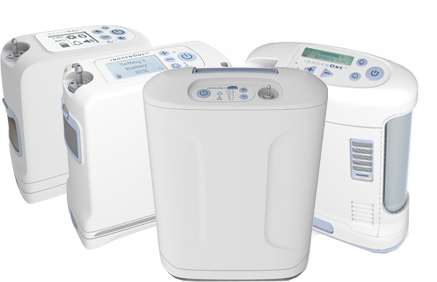
A reliable place you can speak with a respiratory specialist who knows how to connect any patient with the best portable oxygen concentrator of 2020 is at LPT Medical. You can reach out by phone 1(800)-946-1201 or by email at info@ltpmedical.com.
Tip #5 Effective communication
.jpg)
Being able to communicate as a caregiver is hugely important for yourself, and the one you are caring for. Being able to communicate in ways that are clear, assertive, and constructive, helps you to find the help and support you need.
Communicating is not the easiest thing, but here are some things you can practice to get better at it:
- Try to express your feelings using “I” messages rather than using “you” messages. For example saying “I am angry” rather than “You are making me angry” is much more productive and allows you to speak about your emotions without blaming the other person making them become defensive.
- Accept the emotions of others and respectfully take into consideration their point of view. Avoid intentionally hurting anyone’s feelings by violating their rights, you can do this by recognizing another person’s right to express their feelings.
- Be clear and direct with your words. Speak directly to the person. Do not expect the other person to know how you feel if you haven’t explained your emotions. There are no mind readers. When you are direct about what you need or feel, you are respecting the other person's opinion by directing the conversation in a productive manner. It also allows the other person to speak freely and openly about their emotions and the chances of reaching understanding are greater.
- Be a good listener. Listening is the most important aspect of communication.
Overview
Having COPD is a challenging diagnosis, it requires you to alter your daily lifestyle, break bad habits, and much more. With the help of a caregiver, to comfort and support you, you will be able to stick to a treatment regimen that is healthy and promotes an active lifestyle.
As a COPD patient it is important for you to work with your caregiver in times of hardship, and to frequently do things independently when you can. That means you might need to find innovative ways to do your own chores by carrying your own oxygen device. Even if you need a higher output of oxygen, the Respironics SimplyGO is the lightest pulse and continuous flow concentrator on the market, and give the oxygen user freedom and independence that is healthy for the caregiver and patient's relationship.
We hope all the caregivers and COPD patients can find a rhythm going through their day to day lives living with COPD. We hope these tips are helpful for the caregiver to continue to take care of themselves in order to be the best caregiver for their loved one.


 So we can find the best portable oxygen concentrator for your needs!
So we can find the best portable oxygen concentrator for your needs!







